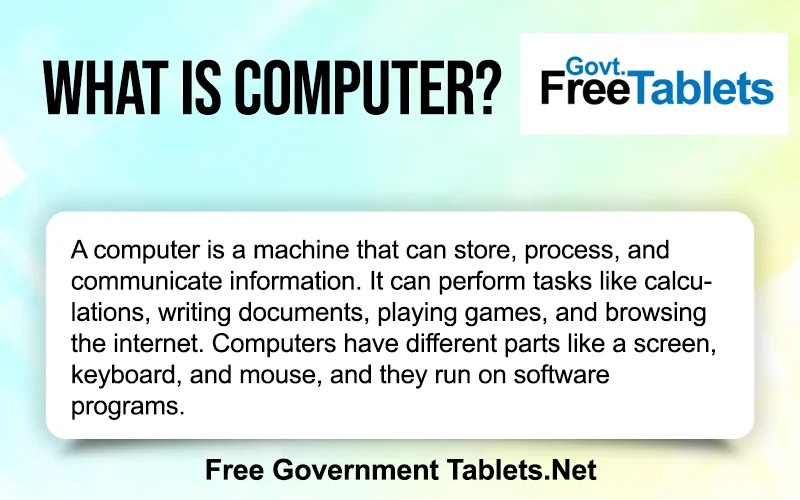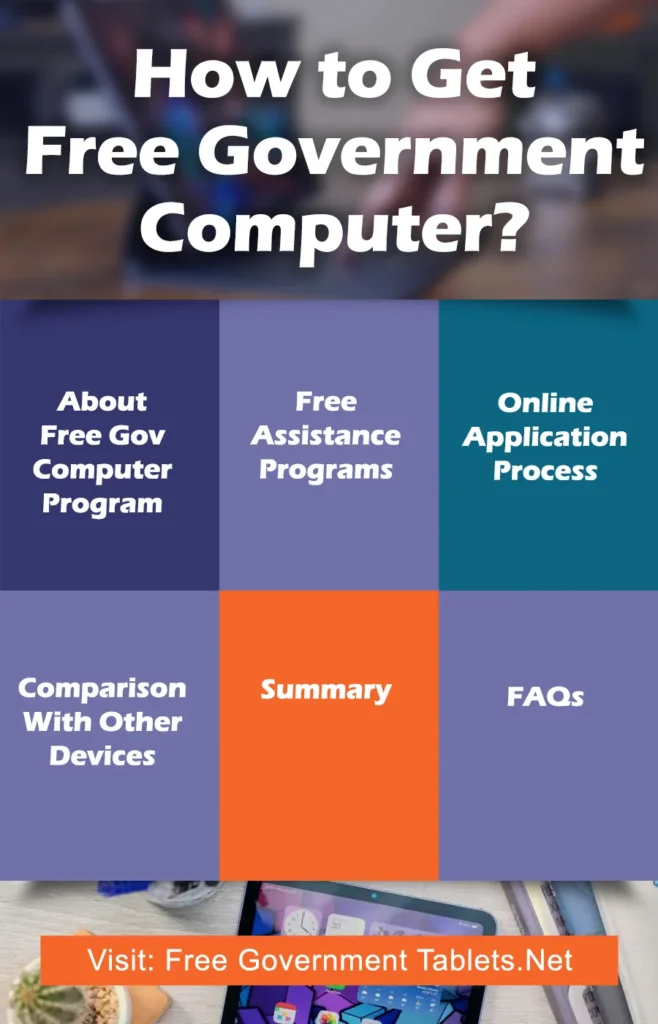Computers are different from other devices because they can do many different things. They can solve problems, store lots of information, and connect people all over the world. Unlike simpler devices like TVs or phones, computers can run many programs and help with work or learning.
State can help by providing free government tablets and computers to those who can’t afford them. This way, everyone can have access to the power of computers for job opportunities, education, and staying connected. Government has introduced a free government computer program in this regard.

In this post, I will guide you how to get a free computer through government, top providers, eligibility criteria, documentation required and online application procedure.
What is Free Government Computer Program?

A Free Government Computer Program is when the government gives out computers for free or at a low cost to people who can’t afford them. This is to help everyone have access to computers, even if they don’t have much money.
The government might work with other groups to get computers to those who need them the most, like people who live in areas with fewer resources or people with low incomes. By doing this, the government wants to make sure everyone can learn, work, and stay connected online, no matter their financial situation.
How to get a Free Government Computer?

Getting a free computer through the government typically involves accessing various assistance programs targeted at low-income families, students, veterans, and seniors. Here are some common programs that may offer free or subsidized computers:
1. ConnectHomeUSA
This program is like a big plan started by the government to help families who live in houses that get support from the U.S. Department of Housing and Urban Development (HUD). The goal is to make sure everyone has a fair chance to use the internet and technology, even if they don’t have a lot of money.
So, they offer cheap or affordable internet and things like computers to people who live in these houses. This way, everyone can have access to important tools for learning and staying connected.
2. E-Rate Program
This initiative assists state libraries get discounts on things like phone service and internet. It’s run by a group called the Federal Communications Commission (FCC), and the Universal Service Administrative Company (USAC) makes sure everything is fair. When schools or libraries are part of this program, they can save money on their phone and internet bills.
Sometimes, schools might even give out computers to students for free or at a lower price because of this program. The ultimate aim is to connect you with your loved-ones and learn without spending too much money.
3. Assistive Technology Programs
Some veterans and older people who have disabilities might be able to get special help with technology from places like the Department of Veterans Affairs (VA) and other groups. These programs can give them computers that are tailored as per your specific requirements.
Sometimes, they can even get these things for free or at a lower price. It’s all about making sure everyone, no matter their age or abilities, can use technology comfortably and easily.
4. Non-profit Organizations
Some groups that aren’t trying to make money, like PCs for People and World Computer Exchange, take old computers that people don’t need anymore and make them work like new again. Then, they give these free government computers to people who don’t have a lot of money, like families with low incomes, students, veterans, and older folks.
They do this either for a very low price or sometimes even for free. These groups often work together with the government and big companies to help make sure everyone has a chance to use computers, especially those who might not have had the chance before.
5. Senior Centers and Community Organizations
Sometimes, places like senior centers or groups in your community offer classes to teach older people how to use computers. These classes help them learn things like sending emails, browsing the internet, and using other programs.
In addition to this, sometimes these places give out computers for free or sell them at a lower price to seniors who want to practice what they’ve learned at home. It’s all about making sure older folks can stay connected and enjoy the benefits of technology, just like everyone else.
6. School Programs
Some schools and colleges want to help students who don’t have a lot of money get computers they need for their studies. So, they might offer free or cheaper computers to students who come from families with low incomes. Sometimes, the school pays for these computers themselves.
Other times, they team up with the government or businesses to make it happen. It’s all about giving every student a fair chance to succeed in their education, no matter how much money their family has.
7. Government Surplus Programs
Sometimes, the government has extra computers and other stuff that they don’t need anymore. Instead of throwing them away, they might give them to groups that help others, like charities, or to people who qualify, like those in need.
You can find out if this is happening in your area by calling or looking at your local government’s website. It’s a good way to get useful things for free or at a low cost while also making sure nothing goes to waste.
To access these programs, individuals typically need to meet specific eligibility criteria, which may vary depending on the program and location. It’s recommended to directly contact the relevant organizations or government agencies to inquire about eligibility requirements and application processes.
Online Application Process
Step 1: Understand Who Can Apply
Before you try to get a free government computer, make sure you know if you’re eligible. Some programs have rules about things like how much money you make, how old you are, if you have a disability, or if you served in the military.
Step 2: Get Your Papers Ready
You might need to show some papers to prove you can apply. These could be things like documents that show how much money you make, where you live, if you have a disability, or if you served in the military.
Step 3: Apply Early and Do What They Say
Lots of people might want free computers, so it’s smart to apply as soon as you can. Follow all the rules and do everything they ask you to do. If you don’t, you might miss out on getting help.
Step 4: Look at Different Programs
There are different programs that can give you a free computer. Don’t just try one—look at all the options and apply for any that you can. That way, you have a better chance of getting a computer.
Step 5. Ask for Help if You Need It
If you’re not sure how to apply or if you’re eligible, don’t be afraid to ask for help. You can talk to the people who run the programs or ask local groups that help with government programs.
Step 6: Use the Extras
Some programs might offer more than just a computer. They might give you internet access, teach you how to use the computer, or help you fix it if something goes wrong. Take advantage of these extra things to make the most of your new computer.
If you get a free computer and you know other people who might need one, tell them about the program. That way, more people in your community can benefit from it. If you get help from a program, it’s nice to say thank you.
You can also tell them how things went and if there’s anything they might improve. This helps them make their programs even better for other people who might need help in the future.
Comparison of Computer with Other Devices
| Feature | Computers | Smartphones | Tablets |
|---|---|---|---|
| Screen Size | Larger screen size, making it easier to see and work on tasks | Smaller screen size, less space to work with | Moderate screen size, smaller than computers but larger than smartphones |
| Typing Experience | Full-size keyboard allows for easier typing and more comfortable typing experience | Touchscreen keyboard can be smaller and less comfortable for typing | Touchscreen keyboard typically larger and more comfortable than smartphones but smaller than computers |
| Multitasking | Can easily run multiple applications and programs simultaneously | Limited multitasking capabilities compared to computers | Moderate multitasking capabilities, but may be limited by device specifications |
| Processing Power | Typically has more processing power, making it suitable for demanding tasks like video editing and gaming | Less processing power compared to computers, but sufficient for most everyday tasks | Moderate processing power, capable of handling basic tasks and some multimedia activities |
| Storage Capacity | Generally offers more storage capacity for files, applications, and data | Limited storage capacity compared to computers, but cloud storage options are available | Moderate storage capacity, suitable for storing files and applications |
| Connectivity | Offers various connectivity options such as USB ports, HDMI ports, and Ethernet for connecting to external devices and networks | Offers connectivity options such as Wi-Fi, Bluetooth, and cellular data for wireless connections | Offers similar connectivity options as smartphones, but may lack certain ports found in computers |
| Productivity | Well-suited for productivity tasks such as document creation, spreadsheets, and programming | Can handle basic productivity tasks, but may be limited by screen size and input methods | Suitable for basic productivity tasks, but may not offer as much functionality as computers |
Frequently Asked Questions (FAQs)
Who can get a free government computer?
People who don’t have much money, like low-income families, students, veterans, and seniors, might be able to get a free computer. Each program has its own rules about who can get one.
How do I apply for a free computer?
To apply for a free government computer, you usually need to fill out an application form and provide some documents to show that you’re eligible. You can find information about how to apply on the government’s website or by contacting local organizations that help with these programs.
What kind of computer will I get for free?
The type of computer you get for free can vary depending on the program. Sometimes, you might get a new computer, but often, it’s a refurbished one that has been fixed up to work like new again. It might not be the latest model, but it should still be able to do most things you need.
Are there additional costs with free computer through the government?
Usually, there are no additional costs to get a government free computer, but it’s essential to read the program’s terms and conditions carefully. Sometimes, you might need to pay for things like internet access or software. Additionally, some programs might require you to attend training sessions or workshops related to using the computer effectively.
Summary
In conclusion, free government computer programs help people who don’t have much money get computers. These programs aim to make sure you can use latest softwares, irrespective of your monetary condition. To get a free computer, you need to understand the rules, gather some papers, and apply early.
It’s good to explore different programs and ask for help if you need it. Once you get a computer, you can use extra services like internet access and training to learn more. Sharing information about these programs with others is also important so that more people can benefit.
Finally, saying thank you and giving feedback can help make these programs even better in the future. With these programs, everyone can have the chance to learn, work, and stay connected online.
